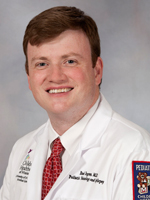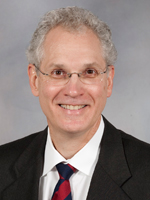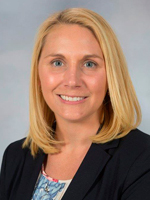Burnout chatter kindles task force action

Published in News Stories on May 25, 2017
Just three months into his pediatric residency 12 years ago, Dr. Brad Ingram stood in a Medical Center parking lot around 11 at night yelling at a woman with a baby.
“I had taken care of her three-month-old, who was discovered missing from the hospital,” said Ingram, now assistant professor of pediatrics, “and we had just found the mom walking the baby back home in a wagon.
“I came at her with what I call a 'howler-monkey response.' This became a turning point for me, because I knew my behavior was really unprofessional; I didn't go to medical school to be a jerk.”
Ingram was showing signs of provider burnout - an issue so prominent now in health care that there is a move afoot at the Medical Center to measure and counter a professional pitfall defined by exhaustion, cynicism and lack of effectiveness.
Ingram is part of that effort as one of 15 members of the Provider Engagement and Burnout Prevention Task Force co-chaired by Dr. Alan Jones, professor and chair of emergency medicine, and Dr. Joshua Mann, professor and chair of preventive medicine.

Dr. Alan Jones, left, and Dr. Joshua Mann co-chair the Provider Engagement and Burnout Prevention Task Force.
“It will have a tremendous impact on this institution,” said task force member Vickie Skinner, project manager for the office of faculty affairs.
It was formed by Dr. LouAnn Woodward, vice chancellor for health affairs and dean of the School of Medicine, partly in response to “a lot of chatter from the AAMC about burnout,” Jones said, referring to the professional association of medical schools and teaching hospitals: the Association of American Medical Colleges.

For complete list of recommendations by the task force, click here.

The urgency is clear, as the task force outlined in its recent report, noting that burnout:
- Touches nearly half of the country's practicing physicians
- Puts “the entire health care system” at risk
- Diminishes a physician's ability to relate to patients, leading to mistakes
- Causes physicians to retire early, worsening the doctor shortage and posing a “public health crisis”
- Afflicts not only established physicians, but also medical students, residents and advanced practice providers, and just as frequently
The upshot can be tragic. Physicians have higher rates of burnout, symptoms of depression and suicide risk than the general population, reports the American Foundation for Suicide Prevention, which estimates the nation loses estimated 300-400 physicians each year by suicide.
“The number amounts to about the size of a medical school class,” Ingram said.
In a 2014 survey conducted by the American Medical Association and the Mayo Clinic, 54.4 percent of physicians reported at least one sign of burnout and expressed lower rates of satisfaction with work-life balance, compared to a similar survey performed four years earlier.
Central to the task force's concerns is this: When providers aren't at their best, their patients' health care may suffer. Such concerns prompted the AMA in 2015 to launch its STEPS Forward program to help physicians “minimize stress and reignite professional fulfillment in their work” (www.ama-assn.org/ama-launches-steps-forward-address-physician-burnout).
At the Medical Center, programs already are in place to address the consequences of stress and burnout, Jones said. So, as the task force's title suggests, “we're mainly dealing with prevention.”

Ingram
The challenge is to stop burnout before a provider enters that “deep, dark place” - where Ingram said he found himself the night of his parking lot confrontation.
“This baby had been very sick and I had been able to help,” he said. “I felt a great swell of happiness and pride. Then I get a call that the baby's missing. I didn't know that the mom had been told she couldn't keep her other child, a three-year-old, with her at the hospital.
“She was in an impossible situation: She had to leave her three-year-old at home, or take her sick child home. And she didn't have a car. But when I found her, I felt this great emotion: 'How dare she?'”
Two culprits were at play here, he said, and they produce burned-out feelings in any profession: “Your job doesn't have the anticipated reward; and you don't have a sense of autonomy.”

Smith
Burnout's baggage is not merely individual in scope; it can be institutional. It can lead to “patient complaints,” said task force member Dr. Patrick Smith, professor of family medicine, chief faculty affairs officer and a clinical psychologist.
“That gets attention.”
Six months of focused attention, in the summer and fall of 2016, yielded seven task force recommendations.
“One is to conduct an anonymous survey about assessing burnout,” Mann said. “This would lead to each department developing a plan specific to its specialty.” Such a plan could embrace mentorship, rewards and recognition, policy rewrites.
No survey specific to burnout has been made yet at the Medical Center; the Comprehensive Faculty Development Needs Assessment, administered from April to December 2015, did raise burnout as an “issue that needed to be addressed,” Skinner said, although it was not a top faculty development priority.

Skinner
For providers, a big frustration is the “administrative burden,” Jones said.
As Ingram put it: “We sign up to be these crusading people riding in on a white horse to save the day, then we find out it's data entry.”
Another faculty concern here: a perceived lack of participation in decision-making and policy. “In their minds, there's not a clear venue to put their ideas for improvement into practice,” Mann said.
That causes more stress, which can lead to distress, which can lead to burnout, Smith said.
Beyond the faculty survey findings, there is anecdotal evidence across the country that health care careers are burning out: “You see an increase in people leaving,” Skinner said. “Some even leave their profession.”
But members of the task force don't want to merely assume there are problems with burnout at the Medical Center. “We need more information,” Skinner said.
The group's next step: “Identify model programs at other academic medical centers that address similar issues we face,” Mann said. “What does a successful program look like? We don't want to re-invent the wheel.”
The work should not be “a one-and-done,” Ingram said. “I applaud this institution for addressing this. We love our work here and need an institution that supports us and loves us back.”


